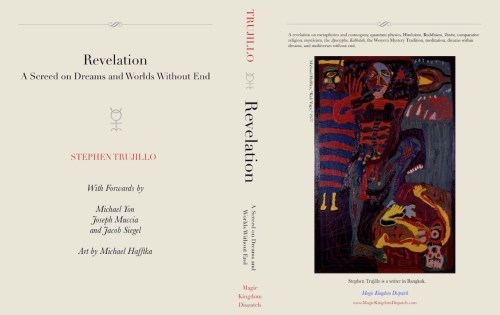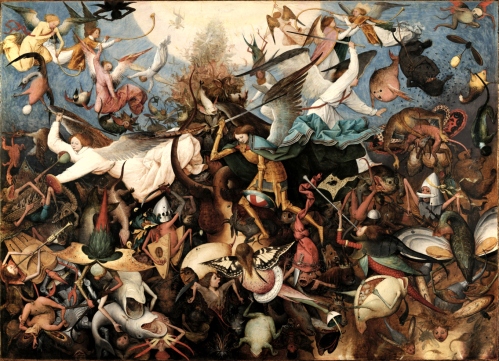“As Rahmani pointed out, some quotations of the Baba text are found in Dionysius Bar Salibi’s work Against the Muslims. They are very brief and restricted to the most suitable sentences (see p. 229, n. 7, and p. 230, n. 1, below); there can be no doubt that they do not go back to a complete text of Baba’s work but are derived from the same collection in which we find them today.
Bar Salibi wrote his work Against the Muslims before his work Against the Jews, which was written in 1477 Sel./l 165-6. Thus, we know for certain that his source for the Baba quotations must have been written before that date, but how long before remains an open question, except that being addressed to unbelievers it is likely to antedate the twelfth century by, at least, a few centuries.
It seems that little attention has been paid to Baba’s prophecies since their publication, and the edition is not easily available. Therefore, a modest attempt to translate the text into English has been appended here:
“The Prophecy of Baba, the God of Harran.
Listen to the statements of Baba who also lived in Harran, whose book is being read attentively by the pagans, who is called by them a prophet, whom they esteem more than all the philosophers, and in whom they take refuge. With the divine power’s approval of his prophecy, he announced and spoke openly about the Messiah, as did Balaam, the soothsayer. He made the following statement in his first book, which is called ‘Revelation‘ (Gelydnd).
I did not want to say these things, but I was required against my will to write about these things that are going to be, while there will be tears and lamentation when they are going to happen. For the light that is prior to the world came to earth and appeared in the body of the earth without mankind knowing it.
Thereafter, it returned again and went up to its place on high by the side of that glory that is concealed from everybody. And while it is there in its place, so-called (?) inhabitants of Harran will come, and the inhabitants of the city of Sin will say that it is Baba’s insanity, <not> wisdom coming from the sons of heaven.
Shaking ‘Azzfiz in which all exaltation (?) is, they will expel those who dwell in it, and it will become a house of martyrs, and all the rest a place of shame.
From the same book:
For the gnosis of light that is immortal, imperishable sacrifices, and incorruptible splendor (will) appear on earth, having its dwelling in heaven and controlling heaven and earth.
Life is in it for all who take refuge in it. The inhabitants of Harran were liars. <It is> all that was and is, and it is prior to everything.
Wisdom takes up residence and dwells in it. Beside this splendor, nothing has subsistence.
Earth, earth! Do not drink error, but know the light that has appeared and subsists and does not perish, ascending on high and serving on earth for years! Shortly, evil will come because of their sin, and their foot will not be steady until they see the light that has appeared and worship it rightly.
From the same book:
And they will say the sweet word: ‘Come, let us fall upon the ground and worship God, the Creator of the earth!’ And there shall be a great and holy temple on earth, and the entire people will bring a sacrifice to God in perfect love.
From the second book:
They will behold the ray that sprang from where they did not expect it. It will be visible from their place.
It will appear with all its appropriate fittings in great, incomprehensible splendor, and all those who dwell on earth will notice the glory of the brilliance that was concealed and became revealed.
I saw in the mind as if I was spoken to as follows: The progeny of splendor and light was born from the earth for gain and loss, for subsistence and fall.
Woe, woe! For after a while, no stone of the house of the gods in your midst that is glorious and exalted like the Capitol in Rome, will be left upon the other. Do not tremble, for if you know the splendor of the ray, many things that (seem) important will be like nought.
The ray of the Lord will openly descend upon the earth, and they will be without signs until the ascent of the radiance. The inhabitants of Persia will come bringing gifts for the ray. Glorious is the divine guidance, and marvelous the miracle that will appear upon earth. It is above words and understanding; it is incomprehensible and unaccountable. Thereafter, the world will dwell in peace for a while.
The kingdom of the east will be aroused. It will go up and destroy the city of Judah. ‘Abor (Eber) will descend into captivity, and Babil will serve in servitude, because of the miraculous progeny, concerning <whom> I (she ?) said …. (?).
Thereafter, the kings of the west will be roused, and they will come up to our place. They will slaughter sacrifices and bring offerings in the midst of ‘Azzuz.
They will seek to abolish the religion, while unable to say so because others after them will believe and rule.
Baba then said that after a long time, a big name from the south will come and sit down in the midst of ‘Azzuz. He will honor its initiates, but over all those who do not heed his words, the sword will rule.
Baba then spoke about the apostles: His apostles, that is, his runners, are contemptible.
He indicated openly that the Apostles of the Messiah are contemptible and simple people (Qiedyote). He sent them out, and they ran over the whole world. With the help of the divine power that was clinging to them, they were able to catch all mankind (and bring them) to Life, doing great and miraculous deeds.
The soothsayer spoke again further about the progeny of splendor on earth, as follows: <Above> all and dwelling in everything —that miracle that was done.”
The Syriac and the Arabic texts have identical remarks concerning the reluctance of the seer, and there is some similarity in the statements concerning the big name from the south and his powerful rule in the one text, and the Abyssinian ruler and the power gained by the good Harranians in the other.
The “sons of heaven” who play an important role in the Syriac text certainly are identical with the “people of heaven” in the Arabic. All these agreements may, however, be credited to the literary type to which both texts belong.
The assumption that the Syriac text is an outright Christian forgery finds support in the fact that the Baba passages appear in the context of clearly supposititious statements attributed to various famous figures. The difference is that Baba was not famous or internationally known but of strictly local interest which at best extended to, say, Edessa and Antioch.
There are the Christian concepts of the ray springing from the glory in heaven and other ideas best explained as Christian in origin. However, if one reads the Syriac text carefully, one cannot help being struck by the tenuousness of the Christian allusions and the fact that practically all of them could have been easily superimposed upon a text that might have spoken about a gnostically transformed Christ in a kind of Biblical phraseology or, rather, about the gnostic light in general.
Concepts such as the light coming down to earth, the gnosis of light, the incorruptible splendor (nuhrd), or the progeny of light and splendor, can be read as gnostic. With regard to the pagan cult in Harran, the text lacks clarity and seems to contain contradictory statements, but expressions of hope for its preservation and renewed glory in the fact of violent attacks upon it by hostile elements (which may have been Christians or Muslims) seem to be prevalent.
The remark about the Apostles must have been originally intended as a slur upon them, branding them as evil characters. Above all, if there really existed a book ascribed to Baba, of which our text has preserved only excerpts, the comparative irrelevance of the excerpts chosen leaves little room for doubt that that book cannot have had much to do with Christianity (which, if it were a Christian falsification, would be its only reason for existence).
There is a good possibility that the Syriac text has, in fact, preserved remnants of Harranian gnostic literature that were only slightly adapted to the purpose which the Christian author had in mind when using them.
For the Arabic text, considerably less doubt seems indicated.
The author obviously hopes for the persistence and flourishing of paganism. It would be far-fetched to assume that a Christian or a member of an heretical Christian sect that had remained at least basically Christian would have gone that far in his mystification in order to provide local color and the appearance of authenticity. We cannot be fully certain, but in all likelihood, the Arabic text is a rare survival of Harranian “Sabian” literature, translated from an Aramaic original presumably dating from the Umayyad period.”
F. Rosenthal, “The Prophecies of Baba the Harranian,” in S.H. Taqizadeh, A Locust’s Leg: Studies in Honor of S.H. Taqizadeh, 1962, pp. 220-32.



